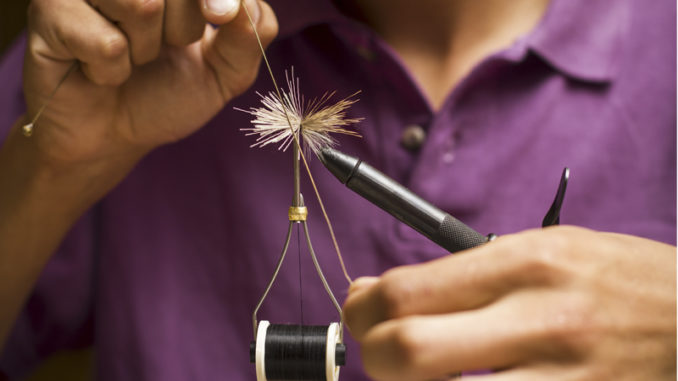
Getting a rise on a hand-tied creation is a thrill
Seeing a trout rise to a fly is always a thrill, no matter how often you fish. Having a trout rise to a fly you’ve tied yourself is a greater thrill.
Tying flies is an art, a craft and a science. It’s the concocting of feathers, fur, thread, yarn and other material to produce a fly that looks enough like an insect to make a trout think it’s the real thing.
Ronnie Setzer of Sylva, N.C., has been tying flies most of his life, professionally for more than 25 years, turning out 20 to 25 dozen flies a week that he sells to local fly fishing shops. He tied his first fly after watching a field full of grasshoppers one fall day when he was 12 years old. Then he kept experimenting until he found the right color and size. He said that was more important than how it looked.
Setzer has never taken a fly-tying class, preferring to teach himself with instructional books and videos. He took up fly-tying, he said, because, “I couldn’t always find the patterns I wanted in the fly shops.”
Tying flies is one of the biggest pleasures of fly fishing
Learning to tie flies can be expensive and time-consuming. But if you want the ultimate experience in fly-fishing, it is worth both the time and expense.
You can buy all-inclusive fly-tying kits online or from a fly shop, or you can put a kit together yourself, which Setzer recommends.
“Kits don’t always have good-quality tools or enough materials for tying a variety of flies,” said Setzer, who recommends buying tools and materials separately. Materials such as thread, yarn, beads and wire can be purchased at a craft shop much cheaper than online or at a fly shop.
The biggest investment is a good quality vise, Setzer said, which can cost as low as $50 or in the hundreds of dollars.
“A good vise will last a lifetime,” he said.
Other necessary tools
Other tools are less costly. These include a whip finisher (to tie off thread and dubbing), fly-tying scissors, a bodkin (to apply glue or lacquer to a fly), hackle pliers (for wrapping hackle around a hook), hair stacker (for holding hair or fur), a dubbing needle (for picking fibers from dubbing) and a bobbin (for wrapping thread onto a hook).
Basic materials include thread in a variety of colors, silver or copper wire thread, glue or lacquer, wax for coating thread, a grizzly saddle for making parachutes and hackle feathers, rooster necks for making tails, peacock feathers, brown feathers, rabbit fur, deer hair and a variety of Mustad hooks in different sizes — most-often used are Nos. 12, 16 and 18.
Fly-tying kits from Orvis, L.L. Bean and Cabala’s include all the basic tools and materials for tying a dozen or more different nymphs and dry flies. Prices range from $50 to $189. Kits include an instructional booklet or video.
Head to the classroom
Although Setzer taught himself, he recommends taking fly-tying classes.
“It’s much easier than trying to teach yourself,” he said,
Most fly-fishing shops offer group and individual instruction, furnishing all tools and materials. Classes generally include instruction in tying basic dry fly and nymph patterns. Participants take home what they make.
A short list of North Carolina fly shops that offer classes are: Davidson River Outfitters near Brevard (888 861-0111), Hunter Banks in Asheville (828 252-3005) and Brookings Anglers in Cashiers (828-743-3768). South Carolina fly-fishing shops that offer fly-tying classes are: Lowcountry Fly Shop in Mount Pleasant (843-388-5337), Chattooga River Fly Shop in Mountain Rest (864-638-2806) and Luthi’s Outfitters in Greenville (864 233-0551).
Another good source for learning about fly fishing and fly tying are Trout Unlimited chapters. You can also teach yourself. A number of instructional fly-tying videos are available free of charge on YouTube.
Get a good book
An excellent resource book is Roger Lowe’s Fly Pattern Guide of the Great Smoky Mountains, which covers 101 traditional fly patterns and provides information on materials used to tie them and is available from Brookings Anglers. A book that Setzer calls “the finest instructional book on the market” is the American Fly Tying Manual by Dave Hughes. The book gives all the ingredients for tying 295 patterns and instruction on tying the flies, plus a section on tools and materials for tying flies.
Don’t want to fool with the time and expense required to learn fly-tying? Buy your own, as most fly fishers do. Flies cost about $2, and you can get by with a dozen or so for fishing year-round.
For winter fishing, buy Blue-Winged Olive, Black Stone, Pheasant Tail and a Hare’s Ear in Nos. 18 to 16. For spring, add a No. 18 or No. 16 regular or parachute Adams and a Blue Dun. In the summer, go with a yellow Caddis, Tennessee Wulff, Royal Wulff, Tellico Nymph and a rubber-legged Girdlebug. In the fall, flies with a bit of yellow always work well, such as a Tellico Nymph, yellow or orange Stimulator, parachute Adams, Prince and a large Stone Fly.
With these patterns, you’ll catch fish just about every time you go out, depending, of course, on weather and stream conditions.

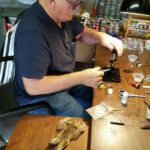
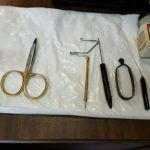
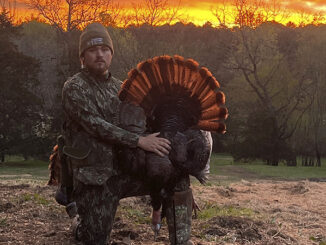

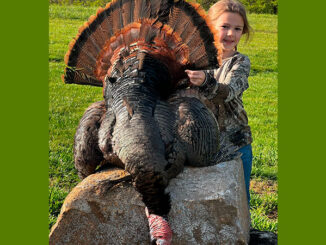

Be the first to comment